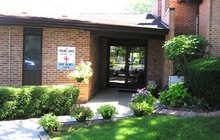
A reflection on: Genesis 18:1-10; Luke 10:38-42
Benedict of Nursia lived in Italy between the 5th and 6th centuries. Born into some wealth, he was sent to Rome for his formal education. This education would have established him in the life of a noble man, but after his education he chose to leave Rome and settle in the desert for a life of studying God and faith.
Over his life time Benedict started and directed twelve monasteries. So profound was his leadership that he is called the founder of Western monastic life for both men and women. For 1500 years monastic communities around the world have been established under the Benedictine order and follow the Rule of St. Benedict.
Essentially this rule is a set of guidelines for living in community; guidelines for developing one’s personal faith life, developing a corporate faith life, and the rules give guidelines for managing a monastic community.
The principle rule of life in Benedictine spirituality is hospitality.
As a result many monastic communities offer retreat centers, grounded in the Benedictine spirituality of hospitality. The Episcopal Church celebrates his feast day on July 11.
Embracing Benedictine spirituality is not limited to monasteries; many churches center their community faith life in the Benedictine spirituality of hospitality. Hospitality is one of the guiding principles of Diana Butler Bass’ book, “Christianity for the Rest of Us,” which many of us have read.
Hospitality means essentially: how we welcome others into our community and how we care for one another. The welcome, in its fullest sense, means all are welcome. Some call this: “radical hospitality.”
Faith communities around the country are finding creative ways to bring this ancient principle alive in their churches. It lives in the way churches worship, the way the congregation is attentive to newcomers, and the way we open ourselves up to everyone who walks in our doors.
Our readings today from Genesis and Luke point us to some of the scriptural foundations for using hospitality as a guiding principle for our lives.
In Genesis we hear the story that underlies the icon of the Trinity hanging in our narthex. This icon, written by a Russian iconographer represents the three persons - “angels” who appear to Abraham and Sarah. When they appear Abraham runs out to greet them and offers them profound hospitality – rest and food, bathing and comfort.
This was not such an easy thing to do, for the three could just as easily have been thieves out to rob them, very common among nomadic people in the desert.
But rather than presume they were thieves Abraham welcomes them. It is this radical hospitality, in the face of fear, that tells the story, for the three persons, are really angels of God – and in the Christian tradition of this icon – they have come to be the Trinity, God, Jesus, and the Holy Spirit.
In radical hospitality we are called to welcome all people because in doing so we also welcome God.
Mary and Martha continue the theme of hospitality and faith by unpacking two sides of this teaching: the balance between doing and being.
The spiritual teaching of this reading asks us to see the sisters of Mary and Martha as if they were two sides of one person. One side is the worker bee – always doing, the other is the quiet thinking side – always being.
This story teaches us that we need to balance these two pieces of our selves in order to live a good faithful Christian life. We must strive to balance the busyness of our lives with time for study, prayer, and quietness.
And then we are to go out and do likewise: we are to live an active life of faith – because the things we do are to be grounded in God through prayer and study.
In other words, the work each of us does in our daily lives, in our jobs, our homes, our lives, is to be grounded in our faith – this is how we live a Christian life.
Balancing life is an on-going process. Some of us are more inclined to be busy, like Martha. However, being overly busy may make us distracted or anxious instead of being grounded in a calm sense of God’s grace. Others of us are more inclined to study, like Mary. But if all we do is study or live quiet lives we may not be active in expressing our faith.
The goal is to do both, so that one informs the other – our quietness, study, or prayer informs our busyness, the work we do becomes the work of God. And the work of God is always grounded in hospitality, which means caring for others in a radical way:
loving God, loving self, loving others.



